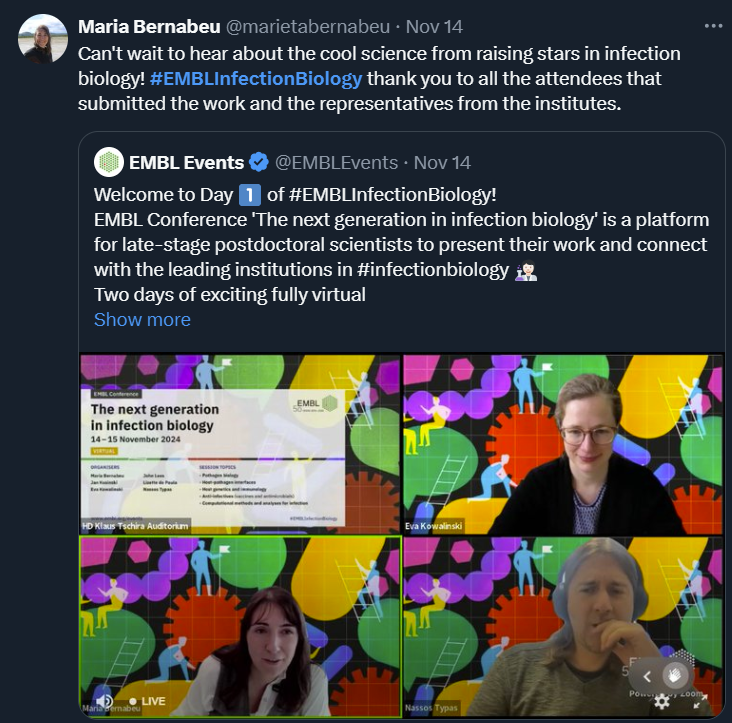A different kind of scientific conference: ‘The next generation in infection biology’ or how to step up your career
The EMBL Conference ‘The next generation in infection biology‘ took place online last month. It was the second meeting in this series and following the success of the inaugural edition, the organisers decided to keep the fully virtual format.
For this year’s conference, we had 78 participants attending virtually along with 28 representatives from 20 different research institutes. There were 10 fellowships provided by the EMBL Corporate Partnership Programme and EMBO.
‘The next generation in infection biology’ is a platform for late-stage postdoctoral scientists in the field of infection biology to present their work and connect with the leading European institutions in infection biology. The speakers are selected based on their track record of research accomplishments as well as their high-reaching future plans, while the audience has a unique opportunity to experience cutting-edge science presented by the rising leaders in this field. To top it all off, the institutional partners provide discussion and networking opportunities.

Amongst the highlights of this year’s programme we had two plenary talks:
- Deciphering Defense Systems of 7th Pandemic Vibrio cholerae presented by Melanie Blokesch from the Global Health Institute, EPFL (Switzerland)
- Malaria research: from basic insights to vaccine studies presented by Freddy Frischknecht from the Center for Integrative Infectious Disease Research (CIID), Heidelberg University (Germany)
A talk on the EU funding infrastructure was another interesting part of the agenda, with Jonathan Ewbank’s presentation European RIs: under-exploited resources for researchers.
Another part of the programme which is paramount to this conference series is of course talking jobs and career progression! On day two, we hosted a career panel Preparing for an academic interview, followed by a Q&A session.

Last but not least, the networking sessions are what makes #EMBLInfectionBiology special! Thanks to multiple breakout rooms the participants got the chance to talk to more experienced researchers as well as the representatives from the leading infection biology institutes. The format of the conference makes it possible to chat in small groups, in a rather relaxed and informal setting, making it easier to discuss both research and career plans and ask questions without the usual stress associated with it.
We hope everyone found this year’s meeting useful and left with lots of new ideas and interesting career prospects. We can’t wait to hear your stories!
And lastly, we would like to introduce the best short talk prize winner. Please join us in congratulating Ana!
Mapping the host-Shigella interface with proximity biotinylation
Presenter: Ana T. López-Jiménez
Authors: Ana T. López-Jiménez, Fabien Théry, Hannah Painter, Dominik Brokatzky, Margarida C. Gomes, Damián Lobato-Márquez, Jonathan Pruneda, Francis Impens, Serge Mostowy

Max Planck Institute for Evolutionary Anthropology, Germany
Abstract:
Shigella flexneri is a Gram-negative bacterial pathogen and causative agent of bacillary dysentery. S. flexneri pathogenicity relies on a virulence plasmid encoding a Type III Secretion System to inject bacterial effectors into the host cell to modulate key aspects of the infection process. Due to its relatedness to Escherichia coli and easy genetic manipulation, S. flexneri has emerged as an important model organism to study cell-autonomous immunity, such as guanylate-binding proteins (GBPs), septin-mediated immunity, and antibacterial autophagy.
Considering that host mechanisms of pathogen recognition and restriction are often located close to the bacterial surface, we pioneered a novel proximity biotinylation approach to map the host-bacterial interface during S. flexneri infection. In brief, we functionalised the surface of S. flexneri with APEX2 using nanobodies. We showed that functionalised bacteria were still infectious and led to biotinylation of proteins surrounding the bacterial surface in human epithelial cells, which were purified and identified by label-free quantitative mass spectrometry. We also showed that biotinylation of the bacterial microenvironment happened in vivo during infection of zebrafish larvae, highlighting the versatility of the method beyond tissue culture cells.
Proteins identified in our proteomic screening include well-characterised host defence factors, such as the recently discovered E3 ligase Ring finger protein 213 (RNF213). Using high-resolution fluorescence microscopy, we validated the localisation of multiple novel candidates whose cellular function is poorly understood, and association to intracellular bacteria was not yet described. The most promising hits are characterised for their recruitment to intracellular bacteria and bactericidal activity. We are currently completing the functional characterisation of these hits, using a combination of siRNA, high-content microscopy and Deep Learning imaging pipelines to monitor (i) recruitment of host factors and (ii) S. flexneri replication and dissemination.
Together, our innovative application of proximity biotinylation will reveal fundamental insights on novel cellular mechanisms and lead to the identification of new antibacterial pathways.
The prize was kindly sponsored by FEBS Letters.
The EMBL Conference ‘The next generation in infection biology’ took place virtually from 14 – 15 November 2024.